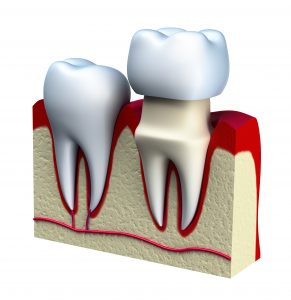Suffolk County Dental Crowns

Crowns, sometimes called “caps” are full-coverage restorations that cover the entire visible portion of your tooth, up to the gumline. They’re used when a tooth is badly decayed or broken to the point that a small filling or more conservative inlay/onlay isn’t appropriate. We also use crowns on top of individual implants for single tooth replacement.
Placing a crown on top of your tooth helps protect it during everyday use, so that your bite can function normally. Plus, our Long Island patients can enjoy the option of having a ceramic crown that’s matched to the shade of the teeth adjacent to it, blending in with your overall smile.
Why Do I Need a Crown?
When a tooth can’t structurally support a smaller restoration, a crown offers the next level of protection. Our Suffolk County dentists may recommend a crown for situations involving:
• Root canal treatment
• Single dental implant placement
• Excessive wear and grinding
• Replacing a large filling
• Severe tooth decay
Getting a Crown
Traditional dental crowns usually require two visits to complete. During your first appointment, we’ll prep the tooth by gently buffing away the outside layer of enamel so that a crown can slip over it without feeling too bulky. Once it’s properly shaped, we’ll take an impression and record the color of your tooth, sending the models off to a lab where your restoration is made by hand. Same day dental crowns are also available.
In the meantime, you’ll wear a temporary crown to prevent any sensitivity.
About two weeks later, you’ll return to Sachem Dental Group to have the permanent crown fitted and bonded in place. Our Long Island dentists will check the bite to ensure everything feels comfortable and you’ll be on your way!
Are There Benefits and Risks to Know About?
Crowns protect your teeth while also adding to enhance your smile’s overall appearance. As a restorative procedure, they provide greater protection than a cosmetic veneer option. But they still have their own benefits and risks, as any treatment does.
However, crowns are not indestructible. They require daily care and maintenance to last for as long as possible. Being too aggressive with your teeth — such as grinding or using your teeth to open packages — could result in the porcelain becoming chipped.
Dental Crown Costs
As with any dental treatment, the cost of your new crown can depend on a number of factors, including the material it’s made from or your dental insurance coverage. In most cases, insurance will cover a portion of your crown. The remaining balance can be paid out of pocket or financed through a 3rd party on a monthly basis that fits your personal budget.
Ultimately, the investment of getting a new dental crown can save you money over time. Not repairing a tooth can lead to it becoming even more damaged, to the point where it’s non-restorable. By then, the tooth has to be extracted and then replaced with a bridge or implant with a crown, which add to the overall cost of your restorative care.
Caring for Your New Crown
Daily care and ongoing maintenance can help you get the most out of your new crown investment. Ideally, we would like for your restoration to last around a decade or longer. To prevent recurrent decay from developing around the margins of your “cap,” it’s important to keep a few things in mind:
Brush twice daily — Brush gently with a non-abrasive toothpaste to keep your crown clean and avoid surface scratches. Clean especially along the gumlines, but without too much force so as to avoid gum recession.
Floss around your crown each day — The cement that holds your crown in place is very durable; flossing will not pull your crown off unless it is already loose. It’s vital to keep the edges of the crown clean, especially between your teeth where a brush cannot reach. Wrap the floss snuggly around your tooth and rub it up and down each side, extending below the gumlines. If mild bleeding occurs, continue to floss daily (as it’s likely due to gingivitis.) Let us know if your floss seems to be catching on any protrusions or starts to shred. If it catches, do not force the floss away from your gums, but rather pull it out through the side.
Protect your teeth against clenching/grinding — Bruxism can wear down both your tooth enamel and your new crown. If ceramic or porcelain chips, it can’t be patched over. Ask us about wearing a protective night guard or bite splint to reduce excessive tension on your smile.
Monitor your gum health — The edges of crowns provide extra surface areas for plaque to adhere to. This can mean an increased chance of gingivitis if brushing and flossing isn’t up to par. Gradually, such gum infections evolve into more aggressive gum disease, which can result in permanent tooth loss. Schedule a cleaning at Sachem Dental Group a least every six months to intercept gum infections while they’re still reversible.
Do You Need a Crown?
If you’ve been putting your crown treatment off or want a second opinion about whether you need a cap, we invite you to schedule a visit at Sachem Dental Group. Our multi-specialty general dentistry practice has been serving Suffolk County and Long Island families for over 35 years. New patients are always welcome!
